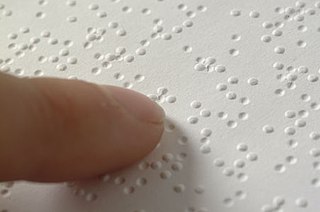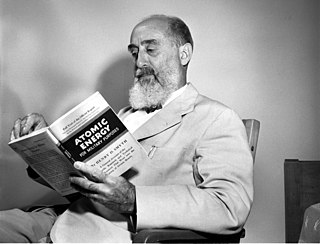
Braille is a tactile writing system used by people who are visually impaired. It is traditionally written with embossed paper. Braille users can read computer screens and other electronic supports using refreshable braille displays. They can write braille with the original slate and stylus or type it on a braille writer, such as a portable braille notetaker or computer that prints with a braille embosser.

Typography is the art and technique of arranging type to make written language legible, readable and appealing when displayed. The arrangement of type involves selecting typefaces, point sizes, line lengths, line-spacing (leading), and letter-spacing (tracking), and adjusting the space between pairs of letters (kerning). The term typography is also applied to the style, arrangement, and appearance of the letters, numbers, and symbols created by the process. Type design is a closely related craft, sometimes considered part of typography; most typographers do not design typefaces, and some type designers do not consider themselves typographers. Typography also may be used as an ornamental and decorative device, unrelated to the communication of information.

Whole language is a discredited philosophy of reading, particularly for teaching literacy in English. Its premise is that learning to read English comes naturally to humans, especially young children, in the same way that learning to speak develops naturally. The method became a major model for education in the US, Canada, New Zealand, and Great Britain in the 1980s and 1990s despite there being little scientific support for the method's effectiveness.

Phonics is a method for teaching people how to read and write an alphabetic language. It is done by demonstrating the relationship between the sounds of the spoken language (phonemes), and the letters or groups of letters (graphemes) or syllables of the written language. This is also known as the Alphabetic principle or the Alphabetic code.

Optical character recognition or optical character reader (OCR) is the electronic or mechanical conversion of images of typed, handwritten or printed text into machine-encoded text, whether from a scanned document, a photo of a document, a scene-photo or from subtitle text superimposed on an image.

Readability is the ease with which a reader can understand a written text. In natural language, the readability of text depends on its content and its presentation. Researchers have used various factors to measure readability, such as

Speed reading is any of several techniques claiming to improve one's ability to read quickly. Speed-reading methods include chunking and minimizing subvocalization. The many available speed-reading training programs may utilise books, videos, software, and seminars. There is little scientific evidence regarding speed reading, and as a result its value seems uncertain. Cognitive neuroscientist Stanislas Dehaene says that claims of reading up to 1,000 words per minute "must be viewed with skepticism".
Words per minute, commonly abbreviated wpm, is a measure of words processed in a minute, often used as a measurement of the speed of typing, reading or Morse code sending and receiving.

In Christian communities, Bible study is the study of the Bible by ordinary people as a personal religious or spiritual practice. Some denominations may call this devotion or devotional acts; however in other denominations devotion has other meanings. Bible study in this sense is distinct from biblical studies, which is a formal academic discipline.

Reading comprehension is the ability to process text, understand its meaning, and to integrate with what the reader already knows. Fundamental skills required in efficient reading comprehension are knowing meaning of words, ability to understand meaning of a word from discourse context, ability to follow organization of passage and to identify antecedents and references in it, ability to draw inferences from a passage about its contents, ability to identify the main thought of a passage, ability to answer questions answered in a passage, ability to recognize the literary devices or propositional structures used in a passage and determine its tone, to understand the situational mood conveyed for assertions, questioning, commanding, refraining etc. and finally ability to determine writer's purpose, intent and point of view, and draw inferences about the writer (discourse-semantics).

Synthetic phonics, also known as blended phonics or inductive phonics, is a method of teaching English reading which first teaches the letter sounds and then builds up to blending these sounds together to achieve full pronunciation of whole words.
Inventive spelling is the use of unconventional spellings of words.

Cambridge English: Young Learners, also known as Young Learners English Tests (YLE), is a suite of English language examinations specially designed for children in primary and lower-secondary school. The tests are provided by Cambridge English Language Assessment.
Miscue analysis was originally developed by Ken Goodman for the purpose of understanding the reading process. It is a diagnostic tool that helps researchers/teachers gain insight into the reading process.

Guided reading is 'small-group reading instruction designed to provide differentiated teaching that supports students in developing reading proficiency'. The small group model allows students to be taught in a way that is intended to be more focused on their specific needs, accelerating their progress.
Language teaching, like other educational activities, may employ specialized vocabulary and word use. This list is a glossary for English language learning and teaching using the communicative approach.

Learning to read or reading skills acquisition is the acquisition and practice of the skills necessary to understand the meaning behind printed words. For a skilled reader, the act of reading feels simple, effortless, and automatic. However, the process of learning to read is complex and builds on cognitive, linguistic, and social skills developed from a very early age. As one of the four core language skills, reading is vital to gaining a command of the written language.

Reading is the process of receiving or taking in the sense or meaning of letters, symbols, etc., especially by sight or touch.
Emergent literacy is a term that is used to explain a child's knowledge of reading and writing skills before they learn how to read and write words. It signals a belief that, in literate society, young children—even one- and two-year-olds—are in the process of becoming literate. Through the support of parents, caregivers, and educators, a child can successfully progress from emergent to conventional reading.

Word recognition, according to Literacy Information and Communication System (LINCS) is "the ability of a reader to recognize written words correctly and virtually effortlessly". It is sometimes referred to as "isolated word recognition" because it involves a reader's ability to recognize words individually from a list without needing similar words for contextual help. LINCS continues to say that "rapid and effortless word recognition is the main component of fluent reading" and explains that these skills can be improved by "practic[ing] with flashcards, lists, and word grids".





